2023年中考英语二轮复习 第十一课时 简单句课件(共35张PPT)
文档属性
| 名称 | 2023年中考英语二轮复习 第十一课时 简单句课件(共35张PPT) | 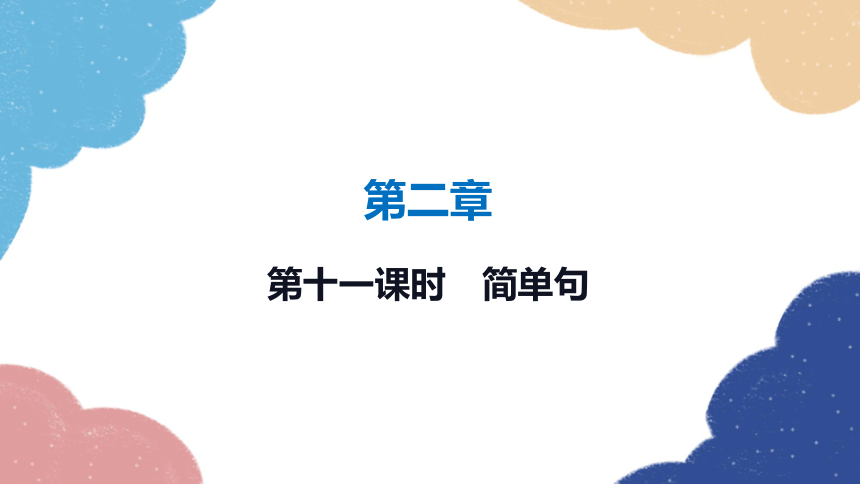 | |
| 格式 | pptx | ||
| 文件大小 | 449.7KB | ||
| 资源类型 | 教案 | ||
| 版本资源 | 人教新目标(Go for it)版 | ||
| 科目 | 英语 | ||
| 更新时间 | 2023-05-23 19:58:16 | ||
图片预览


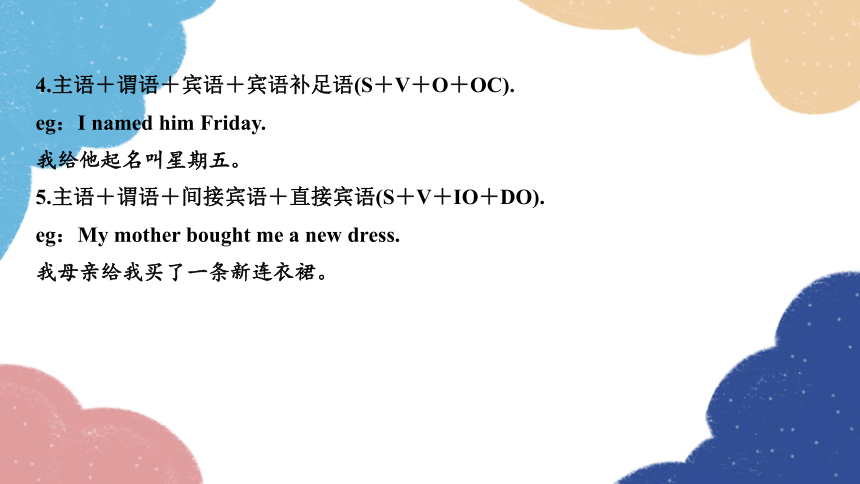
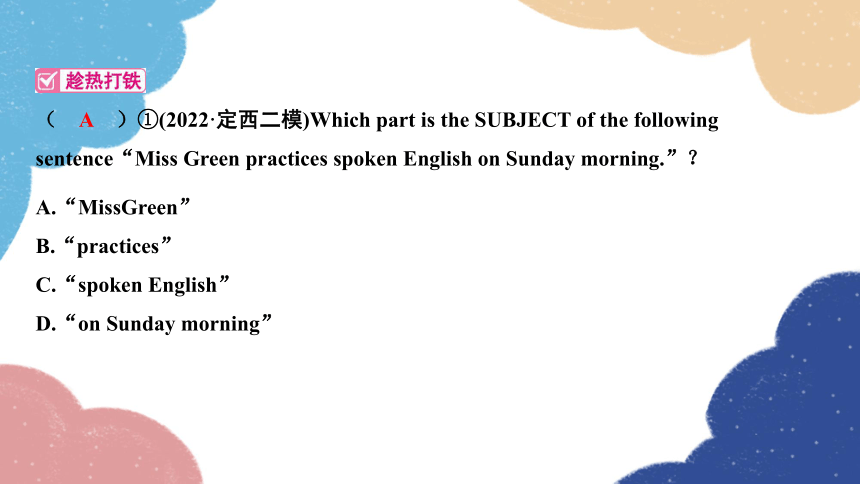


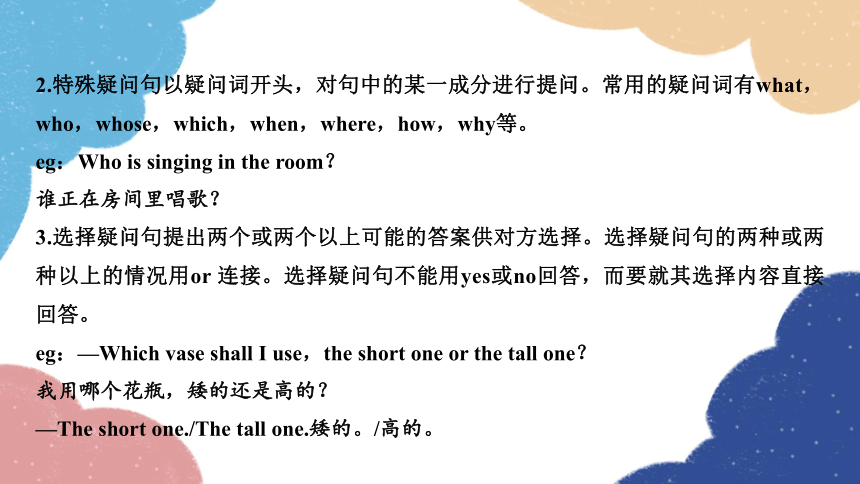
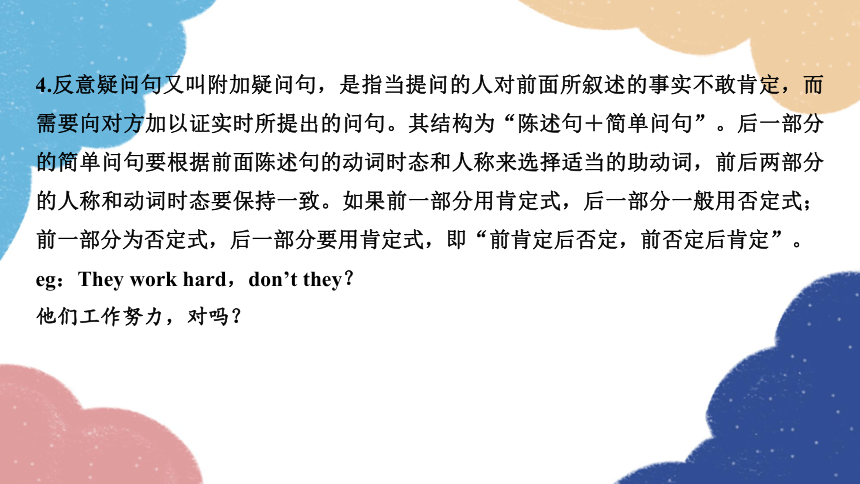
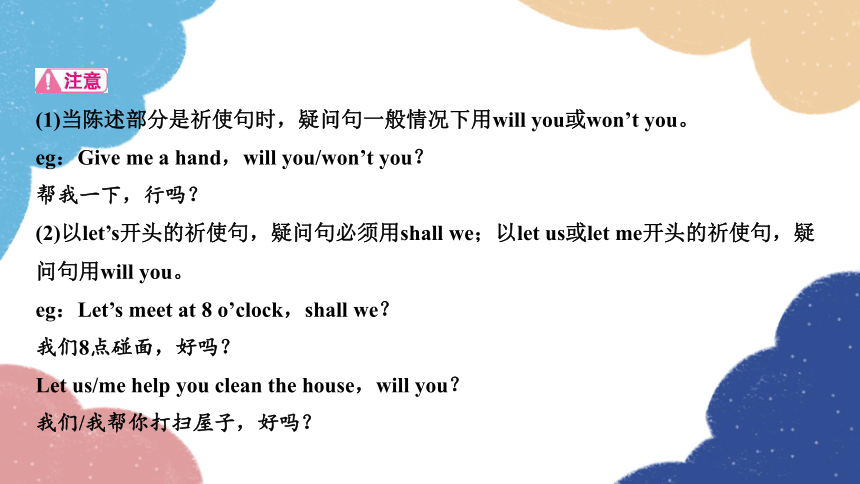
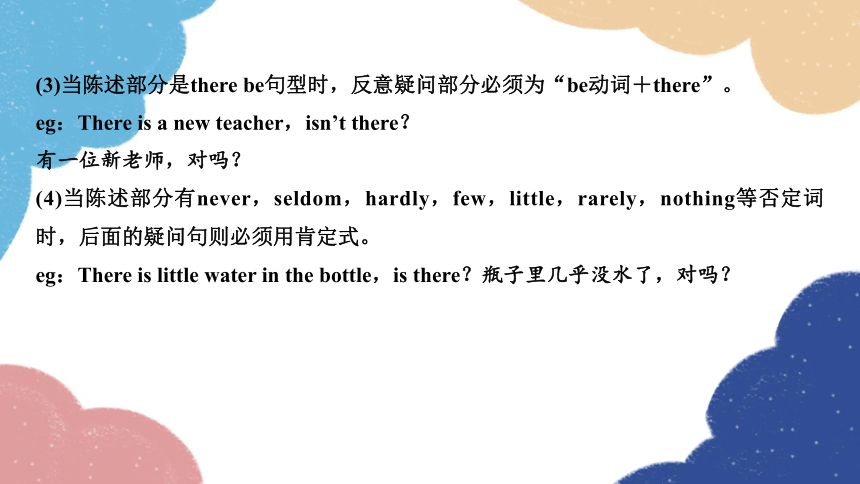
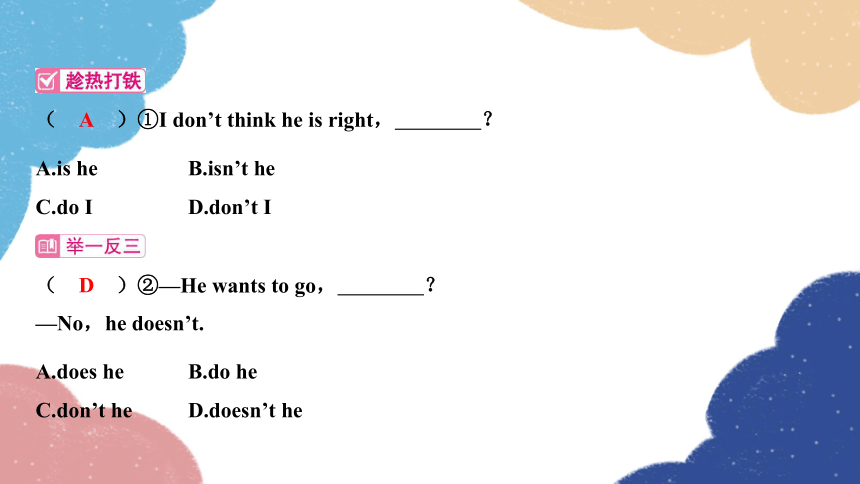
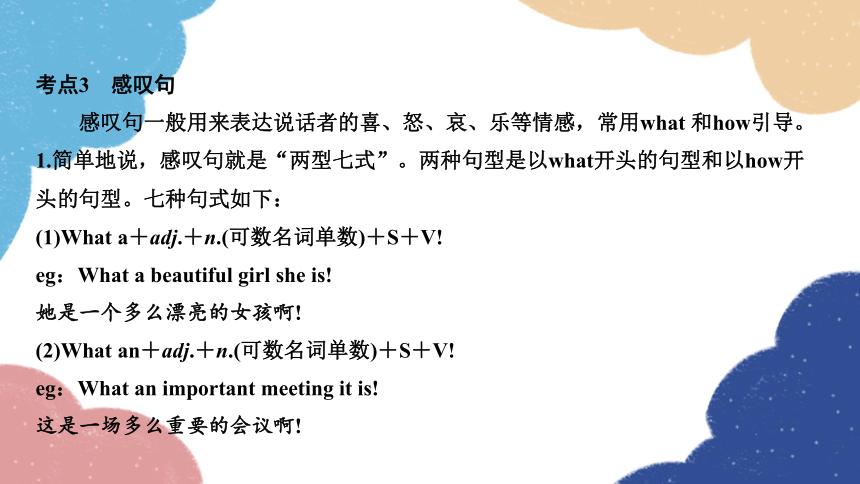
文档简介
(共35张PPT)
第十一课时 简单句
第二章
考点突破
考点1 简单句
只包含一个主谓结构的句子叫简单句。
简单句的基本句型:
1.主语+谓语(S+V).
eg:I work.我工作。
2.主语+系动词+表语(S+V+P).
eg:John is tired.John很疲惫。
3.主语+谓语+宾语(S+V+O).
eg:She studies English.她学英语。
4.主语+谓语+宾语+宾语补足语(S+V+O+OC).
eg:I named him Friday.
我给他起名叫星期五。
5.主语+谓语+间接宾语+直接宾语(S+V+IO+DO).
eg:My mother bought me a new dress.
我母亲给我买了一条新连衣裙。
( A )①(2022·定西二模)Which part is the SUBJECT of the following sentence“Miss Green practices spoken English on Sunday morning.”?
A.“MissGreen”
B.“practices”
C.“spoken English”
D.“on Sunday morning”
A
( B )②(2021·甘肃)Which part is the VERB of the following sentence“Susan walks to school every day.”?
A.“Susan” B.“walks to”
C.“school” D.“every day ”
B
考点2 疑问句
疑问句的主要交际功能是提出问题,询问情况。其分为一般疑问句、特殊疑问句、选择疑问句和反意疑问句。
1.一般疑问句通常用来询问一件事情是否属实,答句通常是yes或no。
eg:—Have you finished your homework?
你完成家庭作业了吗?
—Yes,I have./No,I haven’t.
是的,我完成了。/不,我没有完成。
2.特殊疑问句以疑问词开头,对句中的某一成分进行提问。常用的疑问词有what,who,whose,which,when,where,how,why等。
eg:Who is singing in the room?
谁正在房间里唱歌?
3.选择疑问句提出两个或两个以上可能的答案供对方选择。选择疑问句的两种或两种以上的情况用or 连接。选择疑问句不能用yes或no回答,而要就其选择内容直接回答。
eg:—Which vase shall I use,the short one or the tall one?
我用哪个花瓶,矮的还是高的?
—The short one./The tall one.矮的。/高的。
4.反意疑问句又叫附加疑问句,是指当提问的人对前面所叙述的事实不敢肯定,而需要向对方加以证实时所提出的问句。其结构为“陈述句+简单问句”。后一部分的简单问句要根据前面陈述句的动词时态和人称来选择适当的助动词,前后两部分的人称和动词时态要保持一致。如果前一部分用肯定式,后一部分一般用否定式;前一部分为否定式,后一部分要用肯定式,即“前肯定后否定,前否定后肯定”。
eg:They work hard,don’t they?
他们工作努力,对吗?
(1)当陈述部分是祈使句时,疑问句一般情况下用will you或won’t you。
eg:Give me a hand,will you/won’t you?
帮我一下,行吗?
(2)以let’s开头的祈使句,疑问句必须用shall we;以let us或let me开头的祈使句,疑问句用will you。
eg:Let’s meet at 8 o’clock,shall we?
我们8点碰面,好吗?
Let us/me help you clean the house,will you?
我们/我帮你打扫屋子,好吗?
(3)当陈述部分是there be句型时,反意疑问部分必须为“be动词+there”。
eg:There is a new teacher,isn’t there?
有一位新老师,对吗?
(4)当陈述部分有never,seldom,hardly,few,little,rarely,nothing等否定词时,后面的疑问句则必须用肯定式。
eg:There is little water in the bottle,is there?瓶子里几乎没水了,对吗?
( A )①I don’t think he is right, ?
A.is he B.isn’t he
C.do I D.don’t I
A
( D )②—He wants to go, ?
—No,he doesn’t.
A.does he B.do he
C.don’t he D.doesn’t he
D
考点3 感叹句
感叹句一般用来表达说话者的喜、怒、哀、乐等情感,常用what 和how引导。
1.简单地说,感叹句就是“两型七式”。两种句型是以what开头的句型和以how开头的句型。七种句式如下:
(1)What a+adj.+n.(可数名词单数)+S+V!
eg:What a beautiful girl she is!
她是一个多么漂亮的女孩啊!
(2)What an+adj.+n.(可数名词单数)+S+V!
eg:What an important meeting it is!
这是一场多么重要的会议啊!
(3)What+adj.+n.(不可数名词)+S+V!
eg:What exciting news it is!
多么令人兴奋的消息啊!
(4)What+adj.+n.(可数名词复数)+S+V!
eg:What good teachers they are!
他们是多么好的老师呀!
(5)How+adj.+S+V!
eg:How tall the tree is!这棵树好高呀!
(6)How+adv.+S+V!
eg:How warmly they are discussing!
他们讨论得多么激烈呀!
(7)How+adj.+a/an+n.(可数名词单数)+S+V!
eg:How beautiful a picture it is!
多么漂亮的一幅画呀!
2.以what开头的句型和以how开头的句型可以相互转换。
eg:What an expensive cup!→How expensive a cup!多么贵的杯子啊!
3.在感叹句中常常省略的是充当主语的人称代词和be动词。
eg:What a naughty boy!(省略了he is)
多么淘气的男孩啊!
口诀记忆
感叹句用法巧记
感叹句,表情感,what或how放句前;名词短语跟what,how与形、副紧相连;为使句子更简洁,主谓部分常不见。
( A )①— exciting the speech was!
—Of course!It was a really great inspiration to the world.
A.How B.What
C.How an D.What an
A
( B )②(2020·昆明)— rapid progress our country is making in science and technology!
—So it is.We are enjoying the convenience of modern technology.
A.How B.What
C.What a D.What an
B
考点4 祈使句
用于表达命令、请求、劝告、警告、禁止等的句子叫祈使句。祈使句因对象(即主语)是第二人称,所以通常都省略。祈使句的动词都为一般现在时。
eg:Go and wash your hands.去洗一下手。
1.肯定结构:
(1)动词原形+宾语+其他.
eg:Please have a seat here.请这边坐。
(2)Be+表语+其他.
eg:Be a good boy!要做一个好孩子!
(3)Let+宾语+动词原形+其他.
eg:Let me help you.让我来帮你。
2.否定结构:
(1)在句首加don’t。
eg:Don’t forget me! 不要忘记我!
(2)let型的否定式有两种:“Don’t+let+宾语+动词原形+其他.”和“Let+宾语+not+动词原形+其他.”。
eg:Don’t let him go./Let him not go.
别让他走。
(3)有些可用no开头,用来表示禁止的祈使句。
eg:No smoking!禁止吸烟!
No fishing!禁止钓鱼!
( B )① the radio,please.The baby is sleeping now.
A.Not turn on B.Don’t turn on
C.Not turn down D.Don’t turn down
B
( B )②— late for school again,Tim!
—Sorry,I promise that I .
A.Don’t;won’t B.Don’t be;won’t
C.Don’t be;don’t D.Don’t;will
B
考点5 倒装句
把谓语放在主语之前叫倒装。全部谓语放在主语之前叫全部倒装;只把部分谓语即be动词、助动词或情态动词放在主语之前叫部分倒装。
1.存在句(there be/live/stand/lie/seem等)需要全部倒装。
eg:There once lived an old hunter in the house.这所房子里曾住过一位老猎人。
2.副词here,there,now,then等置于句首(经常与go,come等动词连用),全句需要全部倒装。
eg:Here comes the bus.公共汽车来了。
注意:如果主语是人称代词则不用倒装。
eg:Here they are.他们在这儿。
3.介词短语作为地点状语置于句首,后面如果有lie,live,sit,stand,come,go等动词,全句需要全部倒装。
eg:Into the hall came three women.
大厅里走进来三位女士。
4.当上文所表达的含义也适用于另一个人或物时,要用“so/neither+be动词/助动词/情态动词+主语”,此时谓语的时态、语态应与前句谓语的时态、语态保持一致。
eg:—She has finished her homework.
她已经做完作业了。
—So have I.我也已经做完了。
5.not only...but also...连接两个并列句,且not only置于句首时,前句需要部分倒装。
eg:Not only did he dislike the way we spoke,but he also disliked the way we dressed.他不但不喜欢我们说话的方式,而且也不喜欢我们着装的方式。
( A )①—Why can’t I smoke here?
—At no time in the meeting room.
A.is smoking permitted
B.smoking is permitted
C.smoking is it permitted
D.does smoking permit
A
( D )②Not until the early years of the 19th century what heat is.
A.man did know B.man know
C.didn’t man know D.did man know
D
备考演练
一、词汇运用或完成句子
1.(2022·甘肃) Make (make) sure you lock the door when you go out.
2.More and more young people enjoy reading (read) poems.
3.(2022·天水麦积区模拟)He’ll get back to Tianshui in two days.(对画线部分提问)
How soon will he get back to Tianshui?
4.(2022·天水麦积区模拟)There will be a basketball match this afternoon.(改为反意疑问句)
There will be a basketball match this afternoon, won’t there ?
Make
reading
How
soon
won’t
there
5.(2022·定西二模)请在图书馆内轻轻地走。学生们正在阅读。
Please walk gently in the library.The students are reading.
walk
gently
二、单项选择
( A )1.(2020·白银)I sleep very well,but then I started doing yoga and it really helps.
A.didn’t use to B.used to
C.was used to D.wasn’t used to
( A )2.(2020·天水)Let’s meet at the school gate, ?
A.shall we B.shall you
C.will we D.will you
A
A
( D )3.(2019·金昌)— ?
—At least three times.
A.How much do you pay for TreasureIsland
B.How often have you read TreasureIsland
C.How long does it take you to finish reading TreasureIsland
D.How many times have you read TreasureIsland
D
( A )4.(2019·临夏)—Hello,may I speak to Daisy?
—Hi!
A.This is Daisy speaking.
B.She is Daisy.
C.What is Daisy?
D.That is Daisy.
( B )5.(2022·连云港)Kitty,these books are heavy for you carry.Let me help you.
A.as;as B.too;to
C.such;that D.so;that
A
B
( A )6.(2020·武威)You can use“ ”to be more polite.
A.please B.hello C.wow D.yeah
( C )7.(2020·滨州)—The little boy is only three years old,but he can memorize about 50 poems.
— talented boy he is!
A.How B.How a C.Whata D.What
( B )8.(2022·遂宁)—Sam, run in the hallways.It’s very dangerous.
—Sorry,Ms.Black.
A.do B.don’t C.not D.doesn’t
A
C
B
( D )9.(2019·甘肃) useful the informationyou’ve provided is!
A.What a B.What
C.What an D.How
( B )10.(2022·天水麦积区模拟)What is the sentence pattern of“We all love China.”?
A.S+V B.S+V+O
C.S+V+P D.S+V+O+ OC
D
B
( B )11.(2022·黔东南州)— crowded Zhenyuan was during holidays!
—Luckily,to solve the problem,the government has provided visitors with a lot of parking convenience since three years ago.
A.What B.How
C.What a D.How a
( C )12.(2020·兰州) is one of the four great inventions of ancient China.
A.The car B.The train
C.Paper making D.The computer
B
C
( C )13.(2020·兰州)—Did you use to have long hair or short hair,Sally?
— .
A.Yes,I did B.No,I didn’t
C.Long hair D.Curly hair
( C )14.(2020·天水)— the population ofTianshui?
—It’s about 2.95 million.
A.How many B.How much
C.What is D.Which is
C
C
( B )15.(2018·贵州)He has few friends in his newschool, ?
A.hasn’t he B.does he
C.is he D.doesn’t he
( C )16.(2022·龙东)—It has been rainy for a week.
— terrible weather it is!
A.How B.What a C.What
B
C
( B )17.(2022·铜仁)—Li Ping,I didn’t go
summer camping last year.
— .
A.So did I B.Neither did I
C.Neither I did D.So I did
( C )18.(2018·兰州)Only yesterday find out that his purse was lost.
A.he was B.was he
C.did he D.he did
B
C
( A )19.(2022·无锡)— did the online concert begin?
—You didn’t miss anything.It has just begun.
A.When B.Where
C.What D.Why
A
第十一课时 简单句
第二章
考点突破
考点1 简单句
只包含一个主谓结构的句子叫简单句。
简单句的基本句型:
1.主语+谓语(S+V).
eg:I work.我工作。
2.主语+系动词+表语(S+V+P).
eg:John is tired.John很疲惫。
3.主语+谓语+宾语(S+V+O).
eg:She studies English.她学英语。
4.主语+谓语+宾语+宾语补足语(S+V+O+OC).
eg:I named him Friday.
我给他起名叫星期五。
5.主语+谓语+间接宾语+直接宾语(S+V+IO+DO).
eg:My mother bought me a new dress.
我母亲给我买了一条新连衣裙。
( A )①(2022·定西二模)Which part is the SUBJECT of the following sentence“Miss Green practices spoken English on Sunday morning.”?
A.“MissGreen”
B.“practices”
C.“spoken English”
D.“on Sunday morning”
A
( B )②(2021·甘肃)Which part is the VERB of the following sentence“Susan walks to school every day.”?
A.“Susan” B.“walks to”
C.“school” D.“every day ”
B
考点2 疑问句
疑问句的主要交际功能是提出问题,询问情况。其分为一般疑问句、特殊疑问句、选择疑问句和反意疑问句。
1.一般疑问句通常用来询问一件事情是否属实,答句通常是yes或no。
eg:—Have you finished your homework?
你完成家庭作业了吗?
—Yes,I have./No,I haven’t.
是的,我完成了。/不,我没有完成。
2.特殊疑问句以疑问词开头,对句中的某一成分进行提问。常用的疑问词有what,who,whose,which,when,where,how,why等。
eg:Who is singing in the room?
谁正在房间里唱歌?
3.选择疑问句提出两个或两个以上可能的答案供对方选择。选择疑问句的两种或两种以上的情况用or 连接。选择疑问句不能用yes或no回答,而要就其选择内容直接回答。
eg:—Which vase shall I use,the short one or the tall one?
我用哪个花瓶,矮的还是高的?
—The short one./The tall one.矮的。/高的。
4.反意疑问句又叫附加疑问句,是指当提问的人对前面所叙述的事实不敢肯定,而需要向对方加以证实时所提出的问句。其结构为“陈述句+简单问句”。后一部分的简单问句要根据前面陈述句的动词时态和人称来选择适当的助动词,前后两部分的人称和动词时态要保持一致。如果前一部分用肯定式,后一部分一般用否定式;前一部分为否定式,后一部分要用肯定式,即“前肯定后否定,前否定后肯定”。
eg:They work hard,don’t they?
他们工作努力,对吗?
(1)当陈述部分是祈使句时,疑问句一般情况下用will you或won’t you。
eg:Give me a hand,will you/won’t you?
帮我一下,行吗?
(2)以let’s开头的祈使句,疑问句必须用shall we;以let us或let me开头的祈使句,疑问句用will you。
eg:Let’s meet at 8 o’clock,shall we?
我们8点碰面,好吗?
Let us/me help you clean the house,will you?
我们/我帮你打扫屋子,好吗?
(3)当陈述部分是there be句型时,反意疑问部分必须为“be动词+there”。
eg:There is a new teacher,isn’t there?
有一位新老师,对吗?
(4)当陈述部分有never,seldom,hardly,few,little,rarely,nothing等否定词时,后面的疑问句则必须用肯定式。
eg:There is little water in the bottle,is there?瓶子里几乎没水了,对吗?
( A )①I don’t think he is right, ?
A.is he B.isn’t he
C.do I D.don’t I
A
( D )②—He wants to go, ?
—No,he doesn’t.
A.does he B.do he
C.don’t he D.doesn’t he
D
考点3 感叹句
感叹句一般用来表达说话者的喜、怒、哀、乐等情感,常用what 和how引导。
1.简单地说,感叹句就是“两型七式”。两种句型是以what开头的句型和以how开头的句型。七种句式如下:
(1)What a+adj.+n.(可数名词单数)+S+V!
eg:What a beautiful girl she is!
她是一个多么漂亮的女孩啊!
(2)What an+adj.+n.(可数名词单数)+S+V!
eg:What an important meeting it is!
这是一场多么重要的会议啊!
(3)What+adj.+n.(不可数名词)+S+V!
eg:What exciting news it is!
多么令人兴奋的消息啊!
(4)What+adj.+n.(可数名词复数)+S+V!
eg:What good teachers they are!
他们是多么好的老师呀!
(5)How+adj.+S+V!
eg:How tall the tree is!这棵树好高呀!
(6)How+adv.+S+V!
eg:How warmly they are discussing!
他们讨论得多么激烈呀!
(7)How+adj.+a/an+n.(可数名词单数)+S+V!
eg:How beautiful a picture it is!
多么漂亮的一幅画呀!
2.以what开头的句型和以how开头的句型可以相互转换。
eg:What an expensive cup!→How expensive a cup!多么贵的杯子啊!
3.在感叹句中常常省略的是充当主语的人称代词和be动词。
eg:What a naughty boy!(省略了he is)
多么淘气的男孩啊!
口诀记忆
感叹句用法巧记
感叹句,表情感,what或how放句前;名词短语跟what,how与形、副紧相连;为使句子更简洁,主谓部分常不见。
( A )①— exciting the speech was!
—Of course!It was a really great inspiration to the world.
A.How B.What
C.How an D.What an
A
( B )②(2020·昆明)— rapid progress our country is making in science and technology!
—So it is.We are enjoying the convenience of modern technology.
A.How B.What
C.What a D.What an
B
考点4 祈使句
用于表达命令、请求、劝告、警告、禁止等的句子叫祈使句。祈使句因对象(即主语)是第二人称,所以通常都省略。祈使句的动词都为一般现在时。
eg:Go and wash your hands.去洗一下手。
1.肯定结构:
(1)动词原形+宾语+其他.
eg:Please have a seat here.请这边坐。
(2)Be+表语+其他.
eg:Be a good boy!要做一个好孩子!
(3)Let+宾语+动词原形+其他.
eg:Let me help you.让我来帮你。
2.否定结构:
(1)在句首加don’t。
eg:Don’t forget me! 不要忘记我!
(2)let型的否定式有两种:“Don’t+let+宾语+动词原形+其他.”和“Let+宾语+not+动词原形+其他.”。
eg:Don’t let him go./Let him not go.
别让他走。
(3)有些可用no开头,用来表示禁止的祈使句。
eg:No smoking!禁止吸烟!
No fishing!禁止钓鱼!
( B )① the radio,please.The baby is sleeping now.
A.Not turn on B.Don’t turn on
C.Not turn down D.Don’t turn down
B
( B )②— late for school again,Tim!
—Sorry,I promise that I .
A.Don’t;won’t B.Don’t be;won’t
C.Don’t be;don’t D.Don’t;will
B
考点5 倒装句
把谓语放在主语之前叫倒装。全部谓语放在主语之前叫全部倒装;只把部分谓语即be动词、助动词或情态动词放在主语之前叫部分倒装。
1.存在句(there be/live/stand/lie/seem等)需要全部倒装。
eg:There once lived an old hunter in the house.这所房子里曾住过一位老猎人。
2.副词here,there,now,then等置于句首(经常与go,come等动词连用),全句需要全部倒装。
eg:Here comes the bus.公共汽车来了。
注意:如果主语是人称代词则不用倒装。
eg:Here they are.他们在这儿。
3.介词短语作为地点状语置于句首,后面如果有lie,live,sit,stand,come,go等动词,全句需要全部倒装。
eg:Into the hall came three women.
大厅里走进来三位女士。
4.当上文所表达的含义也适用于另一个人或物时,要用“so/neither+be动词/助动词/情态动词+主语”,此时谓语的时态、语态应与前句谓语的时态、语态保持一致。
eg:—She has finished her homework.
她已经做完作业了。
—So have I.我也已经做完了。
5.not only...but also...连接两个并列句,且not only置于句首时,前句需要部分倒装。
eg:Not only did he dislike the way we spoke,but he also disliked the way we dressed.他不但不喜欢我们说话的方式,而且也不喜欢我们着装的方式。
( A )①—Why can’t I smoke here?
—At no time in the meeting room.
A.is smoking permitted
B.smoking is permitted
C.smoking is it permitted
D.does smoking permit
A
( D )②Not until the early years of the 19th century what heat is.
A.man did know B.man know
C.didn’t man know D.did man know
D
备考演练
一、词汇运用或完成句子
1.(2022·甘肃) Make (make) sure you lock the door when you go out.
2.More and more young people enjoy reading (read) poems.
3.(2022·天水麦积区模拟)He’ll get back to Tianshui in two days.(对画线部分提问)
How soon will he get back to Tianshui?
4.(2022·天水麦积区模拟)There will be a basketball match this afternoon.(改为反意疑问句)
There will be a basketball match this afternoon, won’t there ?
Make
reading
How
soon
won’t
there
5.(2022·定西二模)请在图书馆内轻轻地走。学生们正在阅读。
Please walk gently in the library.The students are reading.
walk
gently
二、单项选择
( A )1.(2020·白银)I sleep very well,but then I started doing yoga and it really helps.
A.didn’t use to B.used to
C.was used to D.wasn’t used to
( A )2.(2020·天水)Let’s meet at the school gate, ?
A.shall we B.shall you
C.will we D.will you
A
A
( D )3.(2019·金昌)— ?
—At least three times.
A.How much do you pay for TreasureIsland
B.How often have you read TreasureIsland
C.How long does it take you to finish reading TreasureIsland
D.How many times have you read TreasureIsland
D
( A )4.(2019·临夏)—Hello,may I speak to Daisy?
—Hi!
A.This is Daisy speaking.
B.She is Daisy.
C.What is Daisy?
D.That is Daisy.
( B )5.(2022·连云港)Kitty,these books are heavy for you carry.Let me help you.
A.as;as B.too;to
C.such;that D.so;that
A
B
( A )6.(2020·武威)You can use“ ”to be more polite.
A.please B.hello C.wow D.yeah
( C )7.(2020·滨州)—The little boy is only three years old,but he can memorize about 50 poems.
— talented boy he is!
A.How B.How a C.Whata D.What
( B )8.(2022·遂宁)—Sam, run in the hallways.It’s very dangerous.
—Sorry,Ms.Black.
A.do B.don’t C.not D.doesn’t
A
C
B
( D )9.(2019·甘肃) useful the informationyou’ve provided is!
A.What a B.What
C.What an D.How
( B )10.(2022·天水麦积区模拟)What is the sentence pattern of“We all love China.”?
A.S+V B.S+V+O
C.S+V+P D.S+V+O+ OC
D
B
( B )11.(2022·黔东南州)— crowded Zhenyuan was during holidays!
—Luckily,to solve the problem,the government has provided visitors with a lot of parking convenience since three years ago.
A.What B.How
C.What a D.How a
( C )12.(2020·兰州) is one of the four great inventions of ancient China.
A.The car B.The train
C.Paper making D.The computer
B
C
( C )13.(2020·兰州)—Did you use to have long hair or short hair,Sally?
— .
A.Yes,I did B.No,I didn’t
C.Long hair D.Curly hair
( C )14.(2020·天水)— the population ofTianshui?
—It’s about 2.95 million.
A.How many B.How much
C.What is D.Which is
C
C
( B )15.(2018·贵州)He has few friends in his newschool, ?
A.hasn’t he B.does he
C.is he D.doesn’t he
( C )16.(2022·龙东)—It has been rainy for a week.
— terrible weather it is!
A.How B.What a C.What
B
C
( B )17.(2022·铜仁)—Li Ping,I didn’t go
summer camping last year.
— .
A.So did I B.Neither did I
C.Neither I did D.So I did
( C )18.(2018·兰州)Only yesterday find out that his purse was lost.
A.he was B.was he
C.did he D.he did
B
C
( A )19.(2022·无锡)— did the online concert begin?
—You didn’t miss anything.It has just begun.
A.When B.Where
C.What D.Why
A
同课章节目录
- 词法
- 名词
- 动词和动词短语
- 动词语态
- 动词时态
- 助动词和情态动词
- 非谓语动词
- 冠词
- 代词
- 数词和量词
- 形容词副词及其比较等级
- 介词和介词短语
- 连词和感叹词
- 构词法
- 相似、相近词比较
- 句法
- 陈述句
- 一般疑问句和否定疑问句
- 特殊疑问句及选择疑问句
- 反意疑问句
- 存在句(There be句型)
- 宾语从句
- 定语从句
- 状语从句
- 主谓一致问题
- 简单句
- 并列句
- 复合句
- 主谓一致
- 主、表语从句
- 名词性从句
- 直接引语和间接引语
- 虚拟语气
- 感叹句
- 强调句
- 倒装句
- 祈使句
- 句子的成分
- 句子的分类
- 题型专区
- 单项选择部分
- 易错题
- 完形填空
- 阅读理解
- 词汇练习
- 听说训练
- 句型转换
- 补全对话
- 短文改错
- 翻译
- 书面表达
- 任务型阅读
- 语法填空
- 其他资料
